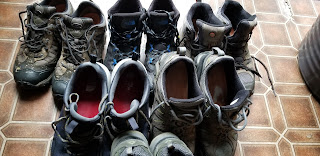Hiking Shoes and other Footwear
I decided to say a few things about boots and shoes we all walk and hike in. Click to enlarge the pictures.
This is my current line up of walking and hiking shoes. Those are some beat up little doggies!
These are older hiking boots still useful some for winter and rocky trails. and for the snow season...
The heavy, the midweight and the new lightweight hikers.
In a spaghetti western this might be a "good, bad and ugly" line-up, but on which days is each shoe a hero or villain? It's just not that simple...
Heavy weights
It's amazing what quality and variety of hiking and walking shoes one can buy today. As an inveterate life long pedestrian, I can only say that technology has improved choice! Pictured below are a pair of classic Swiss 'Raichle' (now Mammut) hiking boots that were sold when I bought them in partnership with REI:
These shoes need conditioning, new vibram soles, certainly new laces for the upcoming fall/winter hiking season in the North Cascades. But they do fit like old jeans, are warm without retaining moisture, shed ankle high snow well and you would have to go some to lose your footing on any trail in pair of these! They also weigh a ton. Now, let's take a look at what most hikers wear now in all but the wettest, snowiest conditions These light hikers are from North Face.
So for our last dog and pony show, I give you a pair of Merrell midweights with pretty thick Vibram soles and Goretex liner. These are pretty darn good boots for most Spring/Fall hikes but a little hot for mid Summer and probably not rugged enough for heavy snow hikes. Like the "Future Lights" above, they can't be resoled either:
So what kind of boots should you own and wear? Well, that's just not an easy question to answer and here are some reasons why:
(1) We all have an unique anatomy. What boot style works for one is anathema to another.
(2) Weather and trail conditions will effect each hiker differently.
(3) Some of you won't be interested in three sets of hikers and there are some good reasons to limit yourself to what feels reliable and comfortable on the trail.
The best I can do on this is too give you some thoughts and guidelines that I have noticed. From there, you will have to engage in some trial and error to determine what is best for you. Here are my thoughts:
(1) I am 190 lb. 58 year old male. My knees and ankle joints have seen some action. The worst mistake for me is a slip, however slight, on a trail. Although I rarely ever fall, even a minor slip can cause me knee swelling that will sideline me or force a shortened trip and a painful walk back to my car.
(2) When I hike I usually use one staff or two depending on the trail. But in the rare case that I don't use any, I am careful. Light hikers are fine on dry trails, but the more muck on the trail the more you benefit from a sturdy boot with a thicker Vibram sole.
(3) I don't like wet feet. Actually, when it is cold and wet, any water against your body will drain your energy considerably. A light warm summer rain is one thing. But in the mountainous Pacific Northwest, hiking all day in serious rain is another. If the boot is not seriously waterproof, I usually don't want to be in it between October and June. Summer is often another story. You will want a shoe that can breath.
(4) You can spend money on a good pair of hiking shoes no matter what the style. There's a good reason for that. On your way down the rocky path you climbed up to get the edge of the glacier, your body will be sore and tired. You want those shoes to hold and support you. I recommend purchasing separate insoles from retailers like SuperFeet if your boots don't support your soles and arches enough.
(5) Footcare is important but it is personal to everyone: Trim your nails, powder your feet, wear good thermal socks, etc. But make sure you have sturdy and comfortable shoes for each season and trail! And keep your feet dry!









Comments
Post a Comment
Comments Moderated. No Spam please.